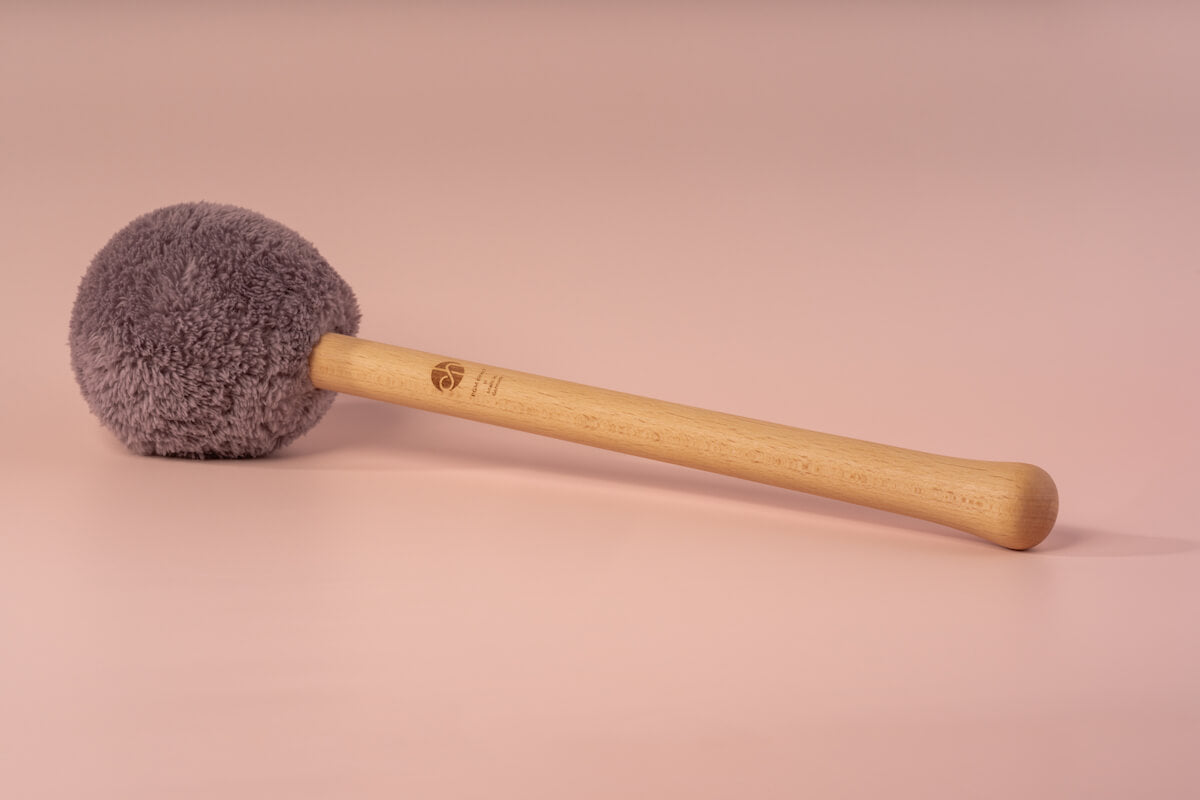White sound - you may have heard of it before or have already produced this captivating sound on your gong. But do you know exactly what makes up this special sound and how it differs from white noise? In this blog post, we explore the concept of white sounds and white noise in more detail and introduce you to the possible effects. We also show you how you can use the gong mallets by Olli Hess to create these sounds and which mallets are best suited for this.
The effect of white sounds and white noises
White Sound and White Noise - both have the special ability to calm your mind and relax your body. The monotonous noise allows you to immerse yourself deeply in the powerful soundscape and other sounds or noise are not perceived at all or are subjectively perceived less. This can lead to a state of meditation and inner peace and help you to reduce everyday stress, improve your sleep or boost your concentration. Many people also use white sounds and white noises as background noise while they work so that they can concentrate better on their tasks.
White sounds and white noises are particularly helpful here:
- Stress management
- Sleep support
- Deepening meditation and relaxation
- Relief for tinnitus
- Improvement of short and long-term memory
- Better concentration and focus
- More effective learning
- What makes White Noise stand out?
The term "white noise" originally comes from sound therapy. It refers to a sound quality that most people perceive as pure, calming and particularly harmonizing. Science attributes the calming effect to the fact that the noise can mask almost all other sounds in the environment. The ear and cerebral cortex are saturated by the even tones and the rest of the sounds cannot overcome this auditory barrier.
Similar to white light, which contains all the colors of the spectrum, white noise contains all the tones of the audible sound spectrum with the same intensity. In contrast to music, white noise does not follow a sound pattern and contains no variation. It always remains the same and monotonous, with a constant frequency and is reminiscent of a heavy rain shower, a roaring waterfall or a humming machine.
In theory, white noise should therefore always sound the same. As each frequency range has the same energy contribution, the sound is uniform. However, differences in recording technology or the devices used for playback can lead to variations. Especially if you search the internet for white noise recordings, you will find that they sound slightly different depending on how they were recorded and played back.
White Noise, Pink Noise, Brown Noise - what's the difference?
Over time, other mixtures of frequencies were developed alongside white noise in order to achieve a relaxing and calming effect. These include pink noise, for example, in which the high frequencies have been limited. This makes it sound less shrill and is therefore perceived as more pleasant by many people. Pink noise is therefore often used to calm small children and babies and can help them fall asleep and stay asleep.
The so-called "brown noise" is a much deeper noise that is more reminiscent of waterfalls or thunder. The lower frequencies are emphasized even more, making it sound somewhat harsher than pink noise. Many people therefore find brown noise more soothing and less disturbing than white noise.
What characterizes White Sound?
White sound is also a continuous sound that contains many frequencies in a similar way to white noise. The big difference, however, is that these are not distributed with the same intensity across the entire audible spectrum. As a rule, white sound is produced with a sound instrument, whereas white noise is usually produced electronically. A large gong is particularly suitable for producing this harmonious and at the same time very penetrating sound. The multitude of frequencies and overtones created during a white sound meditation with a gong can have a relaxing and calming effect, similar to listening to white noise.
White sound does not always sound the same. Depending on the playing technique, the sound instrument, the setting and the mallet used, completely different soundscapes can be created. Basically, it can be said that white sound is richer and more complex in its sound structure. White noise, on the other hand, is perceived as a uniform, flat sound. In addition to sound meditation, white sound is also frequently used in sound therapy and many other areas to promote relaxation and health.
Which gong is best suited for producing white sounds?
In sound therapy or sound meditation, large gongs are generally used to produce white sound. Gongs with a rim, such as the tam-tam gong and all ollihess gongs, with a diameter of 36 inches or larger are best suited. The rim and a corresponding gong size make it possible to produce the rich and broad sound, which contains different frequencies and overtones and therefore fills entire rooms.
Which ollihess mallets are suitable for producing white sounds on a gong?
With the new "Direct Line", Olli Hess has developed a special series of gong mallets that have been specially designed to produce white sound. The professional gong mallet Direct Line differs significantly from other gong mallets: The internal ball made of cork, which has been encased in natural caoutchouc , has not been covered with additional insulation as is usually the case. This design enables particularly powerful sounds. Thanks to the special strength of the core, the noise on the gong can be sustained over a longer period of time.
How to create white sound on your gong
Choose a spot where you would like to play the gong first strike and move from this spot in a circle over the entire surface of the gong. If the sound begins to fade, play the gong again a few centimetres further on. Play the gong very slowly at the beginning. Over time, increase the tempo so that the steady noise becomes more and more pronounced and the vibrations intensify. Be very careful - especially if you are not playing for yourself alone, you should carefully observe how the powerful sound is received by the people who are still picking it up. Experienced gong players have a good feel for this. However, if you are just starting to play white sound, you should always approach it carefully and with particular attention. As a sound maker, you have a significant responsibility that you should never abuse.






Leave a comment
This site is protected by reCAPTCHA and the Google Privacy Policy and Terms of Service apply.